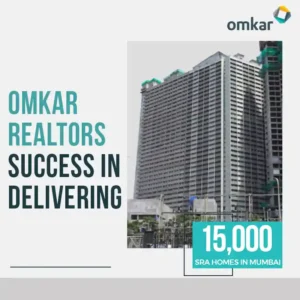Contact No. +91-704 500 5111

Technological Change to survive
Indian real estate sector, today, is facing unique challenges due to an acute shortage of skilled construction workforce, clubbed with rising construction costs. To tackle this situation, the industry is adopting newer and modern construction technologies, not only to overcome the lack of an accomplished labor force, but also to respect delivery timelines as per RERA. – Secondly, the industry with its ever-changing dynamics had to evolve and adopt the modern forms of construction to meet newest deadlines.
Change is inevitable. One needs to change to survive and so does the industry. Omkar Relators also adopted these changes accordingly, keeping in mind the business model of the company which is based on slum redevelopment. For Omkar Realtors & Developers, a market leader in a compact housing, luxury and slum redevelopment, the delivery timeline has always been an important aspect. Hence, only the best construction technology was adopted from time to time, which resulted in the company completing and delivering almost 15 projects on or before deadlines, that too in the pre-RERA era. Omkar has delivered free housing to more than 10,000 families under the SRA scheme over the years. It has employed some of the most advanced technologies for all its projects in Mumbai, working in tandem with foreign construction teams on some projects, with experience in some of the marquee projects, globally. The company has introduced customized technology for semi high-rise and high-rise structures and holds the record for constructing rehab towers of 23 floors in just 18 months, using the Turkish technology called ‘tunnel form’. These advanced technologies have provided a tremendous edge to our construction cycles, ensuring timely and high-quality deliveries.
The industry, over the last couple of decades, has adopted the newest of construction technologies from time to time to order to ensure fast-paced construction to meet the ever-rising demand for housing which is on the rise for time to come. Some of these, adopted by developers in India, have resulted in an array of developments across all metro, tier 1 and tier 2 cities, catering to the rising housing demand. Let’s understand these construction technologies and its benefits.
1. Mivan Technology
Created by Mivan Company Ltd, Malaysia, one of the merits of Mivan Technology is to create residences in larger volumes using its fast-paced construction technique. Mivan shuttering is used to create an aluminium framework that is reinforced using steel. Once the forms are cast in the shape of the building, high quality concrete is poured into the cast, and once dried, removed to reveal hard-concrete structures. The aluminium forms can be reused nearly 250 times, thus reducing wastage on a construction site.
2. Self-healing concrete
Permeable or porous concrete is just as strong as traditional concrete but uses larger stones, less sand and contains between 15% – 20% of empty space. It allows rainwater to seep down into the ground, instead of pooling or running off. Self-healing concrete can contribute towards extending the life of buildings, saving repair costs and eliminating the need for costly upgrades.
3. Modular construction
In other words, a process where a building is constructed off-site, with the same materials and standards as a conventionally built building, and then delivered to the intended site of the project. This method of construction has also proved to cut down on costs and lead times, hence increasing efficiency.
4. Structural Insulated Panel Technology
Featuring an insulated core with timber facing on either side, these panels provide excellent insulation and thermal performance. Particularly important in countries that experiences sub-zero temperatures, SIPs can be mass produced, while keeping waste to a minimum. Easy installation, lightweight, energy efficient and sustainable – these factors make it a gamechanger in the field of construction.
5. Robotics
Already creating waves in medicine and health industry, robotics could become the future for real estate as well. Not too far into the future, we could witness robots laying bricks, tying rebar, and even complete most of the current man-operated construction projects.
6. Pre-cast technology
The biggest advantage of pre-cast technology is increased uniformity and consistency in the final product with excellent quality control in place, due to off-site production. This also helps in cutting down time during construction with freedom to produce construction modules in desired shapes and sizes.
7. Self-climbing jump-form system
Jumpform systems comprise the formwork and working platforms for purposes of cleaning/fixing it, and concreting. Self-climbing systems does not require a crane as it climbs on rails up the building by means of hydraulic jacks. These are not labour intensive, are apt for high-rise and super high-rise structures, are operational in high winds and facilitates a high level of safety on site.
8. Tunnel form system
A formwork system that allows the contractor to cast walls and slabs in one operation in a daily cycle, tunnel form ensures high quality construction with a record slab cycle of 2 days. Imbibing exceptional flexibility in both design and layout, this system is apt for low and mid high-rise structures and is recognised as a modern method of construction (MMC).
Benefits to developers and consumers
The advanced technology that is being used majorly helps in positively transforming the process of construction. The government’s increased focus on urban development, Smart Cities and on achieving the agenda of ‘Housing for All’ further augments the necessity for construction technology to build superior quality at a noteworthy scale.







